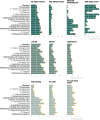Lifestyle-associated health risk indicators across a wide range of occupational groups: a cross-sectional analysis in 72,855 workers
- PMID: 33148214
- PMCID: PMC7641800
- DOI: 10.1186/s12889-020-09755-6
Lifestyle-associated health risk indicators across a wide range of occupational groups: a cross-sectional analysis in 72,855 workers
Abstract
Background: Identify and compare health risk indicators for common chronic diseases between different occupational groups.
Methods: A total of 72,855 participants (41% women) participating in an occupational health service screening in 2014-2019 were included. Occupation was defined by the Swedish Standard Classification of Occupation, and divided into nine major and additionally eight sub-major groups. These were analysed separately, as white- and blue-collar occupations and as low- and high-skilled occupations. Seven health risk indicators were self-reported: exercise, physical work situation, sitting at work and leisure, smoking, diet, and perceived health, whereas cardiorespiratory fitness, BMI and blood pressure were measured. These were further dichotomized (yes/no) and as clustering of risk indicators (≥3 vs. <3).
Results: The greatest variation in OR across sub-major and major occupational groups were seen for daily smoking (OR = 0.68 to OR = 5.12), physically demanding work (OR = 0.55 to OR = 45.74) and high sitting at work (OR = 0.04 to OR = 1.86). For clustering of health risk indicators, blue-collar workers had significantly higher clustering of health risks (OR: 1.80; 95% CI 1.71-1.90) compared to white-collar workers (reference). Compared to high-skilled white-collar workers, low-skilled white-collar workers had similar OR (2.00; 1.88-2.13) as high-skilled blue-collar workers (1.98; 1.86-2.12), with low-skilled blue-collar workers having the highest clustered risk (2.32; 2.17-2.48).
Conclusion: There were large differences in health risk indicators across occupational groups, mainly between high-skilled white-collar occupations and the other occupations, with important variations also between major and sub-major occupational groups. Future health interventions should target the occupational groups identified with the highest risk for effective disease prevention.
Keywords: Blue-collar; Cardiorespiratory fitness; Lifestyle; Low- and high-skilled occupations; Occupational groups; Occupations; Physical activity pattern; Risk indicators; White-collar.
Conflict of interest statement
Gunnar Andersson and Peter Wallin are employed at HPI Health Profile Institute.
Figures


References
-
- Tsutsumi A, Kayaba K, Tsutsumi K, Igarashi M. Association between job strain and prevalence of hypertension: a cross sectional analysis in a Japanese working population with a wide range of occupations: the Jichi medical school cohort study. Occup Environ Med. 2001;58(6):367–373. doi: 10.1136/oem.58.6.367. - DOI - PMC - PubMed
MeSH terms
Grants and funding
LinkOut - more resources
Full Text Sources
Medical

